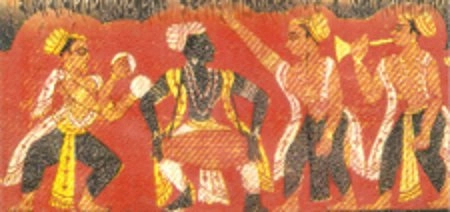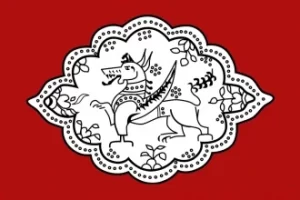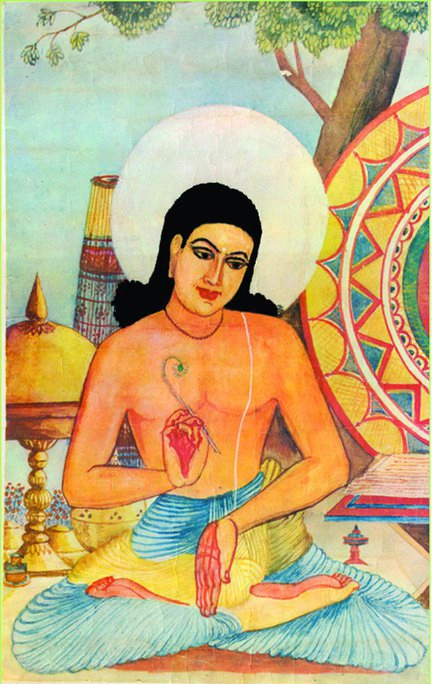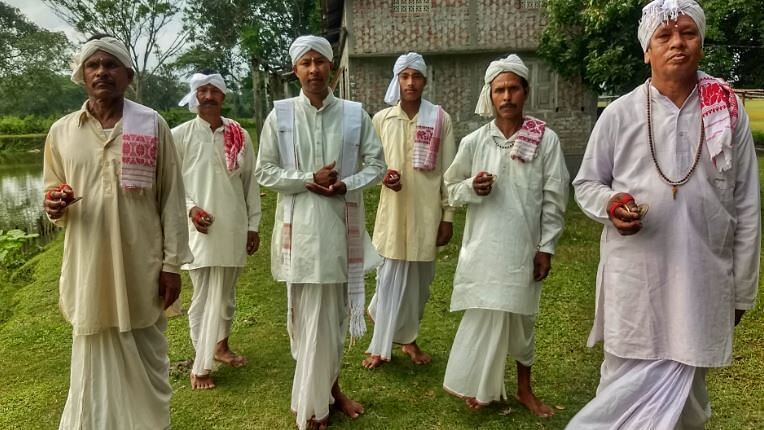Paintings are probably the oldest form of historiography which has quickly developed into an art form. It started off as storytelling and later developed into something more complex and intricate. We have all seen, in person or through some media, the ancient wall paintings in caves to the famous Guernica. We have seen the Monalisa to Mother Teresa. But today I am going to talk about the less talked about paintings from Assam.
The traditional paintings of Assam go way back in history and have developed ever since. But they are less known in the modern world and probably why they are less, if not at all, practised. Usually one can see those paintings in museums and Satras (Vaishnavite Monastries set up by Srimanta Shankardev and his disciples). I first saw some in the Museum of Srimanta Shankardev Kalakhshetra in Guwahati when I was 10 years old. Then later I started noticing that the paintings of Assam are different from the famous paintings from all over the world. These paintings are colourful and can be found in manuscript scrolls (Xanchipat) or in individual works.
The traditional paintings from Assam did not have abstraction as the subject matter. If one observes a painting, it mostly depicts a story from the epics or Puranas or Vedas or sometimes, even some local myth or folklore. Some scrolls have paintings accompanying texts.
Paintings from Assam can be divided into two major schools –
The Assam School, are the ancient and medieval paintings made by natives and mostly based on Parbas from Mahabharata, Kandas from Ramayana or stories and legends from Puranas or Vedas. They are mostly found on Xanchipat scrolls or Tulapat or sometimes even tapestries made from silk or cotton. This school can be traced back to the 7th century AD.
The Tai-Ahom School was brought into the lands of Assam by Chao-lang Syu-Ka-Pha and the Tai people that migrated with him. The most notable subject of art is probably the Ngi Ngao Kham, the mythical dragon-like winged lion.

The Assam School progressed and evolved with the rise of the Neo-Vaishnavism movement started by Srimanta Shankardev. Shankardev himself was an accomplished artist and used art as a medium of preaching Ek Xoron Naam Dharma in Assam. Some of his original paintings are preserved in the Assam State Museum and others can be found in numerous xattras set up by Shankardev, his disciple Madhavdev and their disciples across Assam and outside. The Guru used paintings to illustrate the cover pages or wooden cases prepared to cover his manuscripts. The usage of paintings and art by Vaishnava saints and preachers gave rise to a cottage industry where people took up jobs like the preparation of colours and pigments, and the preparation of scrolls and brushes. It should be mentioned here that the industry grew in tandem with the industries and enterprises started by the Ahoms. Another thing that is worth mentioning here is that the influence of Kamatapuria and Goalparia art and craftsmanship later got mixed with this school and together became the Assam School.

The Tai-Ahom School or simply the Ahom School of painting entered Assam with Syu-Ka-Pha in 1228 AD. The influence of Buddhist art and the Indo-Chinese way is exceptionally visible in Ahom’s artworks. The use of vibrant colours is similar to that of the old Assam type yet the difference in the work is noticeable. Paintings of Ngi Ngao Kham and 16 heavens and 16 hells are more common in Ahom paintings. However, the rise of Vaishnavism soon encompassed in its arms whatever painting style was prevalent in the valley. The orthodox Ahom style, later on, remained confined to Ahom courts and Xaalgram temples. Even that was too phased out eventually and people probably stopped practising, which might be why it is hard to find one. Later during the 18th century, when Mughals came in contact with the Ahoms, due to war or related activities, the painting style got influenced by the Mughals’ styles and came to be known as the Court Style or Royal Style.
Painting as a profession was not a lucrative job in medieval Assam. Although many Ahom Swargadeos patronised art and crafts, it was limited to the royals only. The xattras, however, employed people to make illustrations on the manuscripts written by Vaishnava Saints. They were called Khanikars. Unfortunately, the Khanikars never received any proper credit for their work and were simple clerics. Other jobs that sprung out were Likhaks who beautifully transcribed the work of the Gurus and Patuas who prepared the Xanchipat scrolls.

Although all kinds of colours are seen in Assamese paintings, different shades of yellow, green and red are prominent. In Ahom styles too, colours like Turquoise and Golden can be seen extensively. The materials used to make these colours are indigo, ochre yellow (geru mati), vermillion (hengul), yellow arsenic (haital), and lamp-black. The painting compositions were simple and horizontal, mostly on the same plane without many complex features unlike paintings of contemporary Persia and Europe. However, the vibrant colours gave the paintings life and made them interesting to look at and aided in understanding the accompanying text.
With time and invasive modernization, the traditional way of Assamese painting is almost lost. Although some still practice the style, the media is a modernized one. Some works of greats like Adya Sharma too resemble the Assamese style of painting. We can also look at the painting of Srimanta Shankardev by Kalaguru Bishnu Prasad Rabha and find a resemblance to the traditional style of Assamese painting. Though the future of Assamese painting does not look promising and we may or may not see more work in the field, it is of utmost importance that the existing ones are preserved using modern technologies.
Khanikars are not just xattra clerics who painted on manuscripts. They were also sculptors, mask makers, engravers and carpenters. Villages in old Assam had a Village Khanikar who was responsible for designing and making the props, costumes and sets of any Bhaona or theatricals. The title was given and the responsibility was hereditary. Even now khanikars are responsible for making bhaonas and naats align with traditionality.
(This article simply gives an overview of the Assam style of painting and does not detail every aspect of it)
References –
http://www.bharatonline.com/assam/art-craft/paintings.html
https://cultureandheritage.org/2022/08/manuscript-paintings-of-assam-in-the-north-east-of-india.html
https://www.sahapedia.org/manuscript-painting-of-assam-historical-and-contemporary-perspectives
Picture Source – Creative Commons




